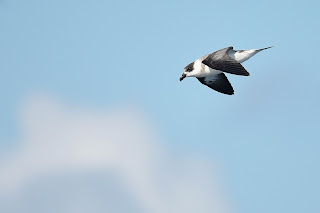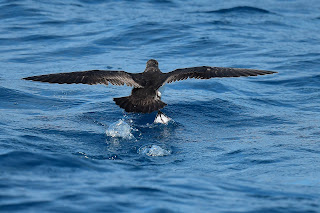The wind was blowing for a few days before our final scheduled trip of the year to the Gulf Stream, but by Saturday there was just a nice, long period (ten second) swell of about 6 to 7 feet from the east / southeast and wind about 15 miles per hour from the west /northwest. Skies were sunny and we were all quite content heading offshore on such a gorgeous morning! There were ducks moving by as we headed offshore, those we could get a good look at were Blue-winged Teal, but there were hundreds over the course of the day that slipped by just far enough to be noted only as duck sp. A couple of Red-necked Phalaropes flew by as we approached a temperature break and the first bit of Gulf Stream current. Just a few minutes later we crossed the shelf break and almost immediately we began to see Black-capped Petrels! This time of year these attractive Gulf Stream inhabitants have finished molting and look incredible in their fresh feathers! We saw both light and dark form individuals over the course of the day and our count of almost 100 is conservative since they were on the horizon for most of the morning. We also were very happy to find some Audubon's Shearwaters just over the break, they were a challenge this summer to find! Little did we know that morning that they would be the most numerous species of the day... A couple of Great Shearwaters passed by, giving us good views and nice comparisons with the larger Atlantic Cory's we had been seeing. And our slick finally enticed a few Wilson's Storm-Petrels to join us giving everyone a chance to study these small, Antarctic nesting world travelers. Some even showed off the yellow webbing between their toes!The 1100 period found us heading to a shearwater flock with a couple of Sooty Terns up high, one adult with its attendant juvenile! This is a great species to find here in October since most have moved on to the south already. This flock had mostly Audubon's Shearwaters and Atlantic Cory's with a few Black-capped Petrels and a handful of Great Shearwaters. The next period brought us a flock with over 150 Audubon's! It was incredible to look around and see them everywhere low over the water! As Brian mentioned if you were just a short distance away you could easily miss how many were around, and this in an absence of southerly wind preceding our trip. The wind had been from the north for days, so it is likely these birds were coming down from some time spent in the Gulf Stream offshore of the mid-Atlantic and New England, they were probably repositioning back south. It was really incredible to see them in their own little "beehives," zipping around one another and calling. A couple of times we saw them gathered around what looked to be moon jellyfish (Aurelia aurita) diving underneath and around them, presumably consuming small fishes and other prey items associated with these floating creatures.
So while we did see other species out there, the highlight of this trip were those species who can be found utilizing the Gulf Stream year round. We had at least a couple of Scopoli's that were photographed, but not seen well, and a distant Pomarine Jaeger out in the deep...plus a couple of young Laughing Gulls who were very happy to find the pieces of fish we dispensed!
Thanks so much to everyone who joined us out there - we had a great group of participants - and a huge thank you to Sarah Toner and Larry Chen who drove down to help Brian and me lead the trip! All photos today are taken by me.
~Kate Sutherland
Species List 7 October 2023
Black-capped Petrel - 96 to 106
Atlantic Cory's Shearwater - 20
Scopoli's Shearwater - 2
Cory's / Scopoli's - 121
Great Shearwater - 12
Audubon's Shearwater - 384 to 394
Manx / Audubon's - 1 (not seen well enough to tell, nearshore)
Wilson's Storm-Petrel - 10 to 12
Red-necked Phalarope - 2
Pomarine Jaeger - 1
Sooty Tern - 2
Common Tern - 2 nearshore
Royal Tern - 4 nearshore
Laughing Gull - 9 (2 juveniles offshore)
Herring Gull - 2 nearshore
Great Black-backed Gull - 3 nearshore
Blue-winged Teal - 53 (15 offshore)
duck species - 285 to 305
passerine sp - 1
A few more Black-capped Petrels
One of the Atlantic Cory's Shearwaters we saw

























































